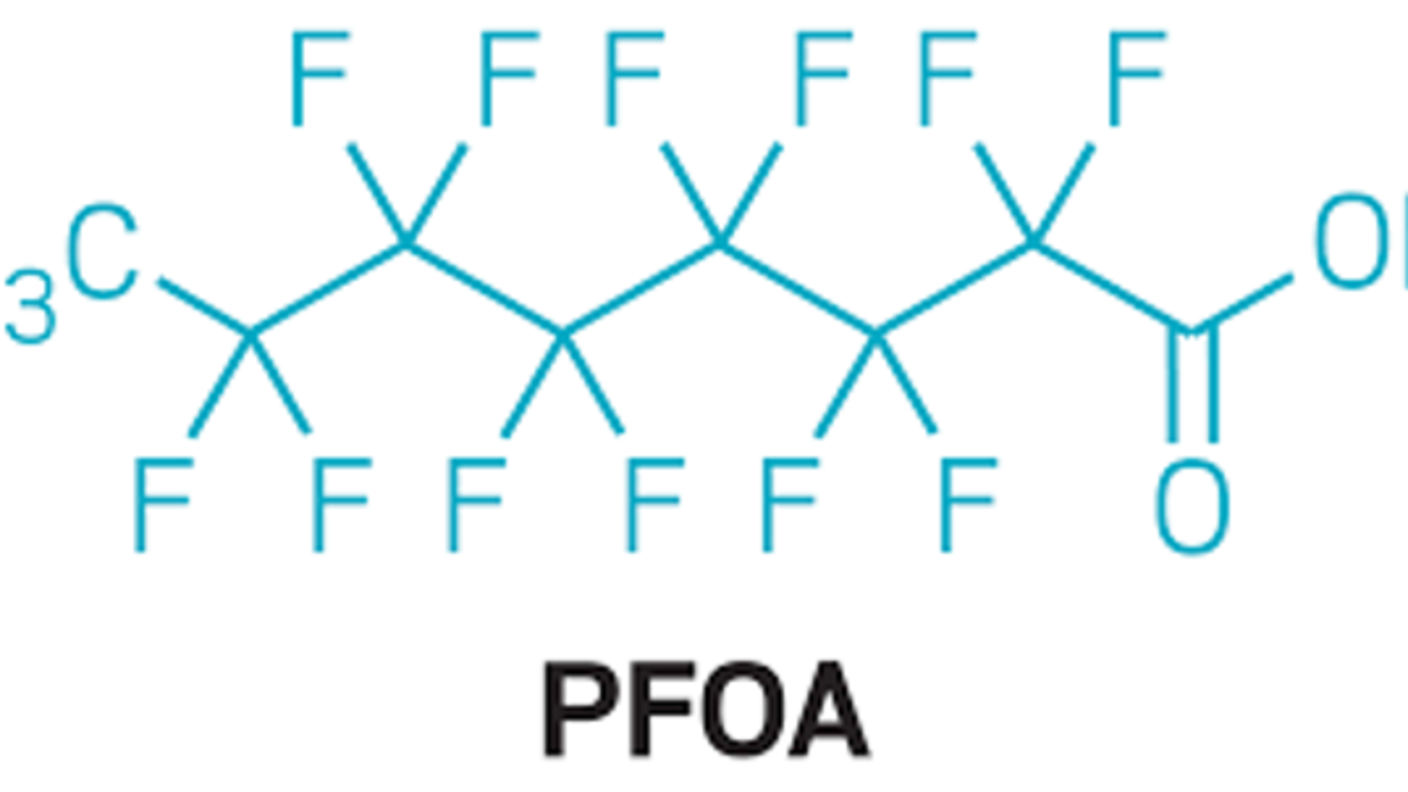PFAS and Cancer: Occupational and Environmental Epidemiology Branch Research on “Forever Chemicals”
, by Elise Tookmanian, Ph.D.
Per- and polyfluoroalkyl substances (PFAS) are a unique class of chemicals. Their many fluorine-carbon bonds render them both hydrophobic and lipophobic, repelling both water and oil and resistant to degradation. These distinctive properties lend themselves to many applications, from waterproof raincoats to nonstick cookware to firefighting foams. Yet these same properties make them potentially hazardous; some PFAS are highly persistent in the environment and are widely detected in humans, raising concerns about potential health effects. In 2014, the International Agency for Research on Cancer (IARC) Monograph programme classified perfluorooctanoic acid (PFOA), the most well-studied PFAS to date, as a possible human carcinogen.
Early Studies in Highly Exposed Individuals
When PFAS were first used in the 1940s, low levels of exposure were considered harmless, but they eventually came under scrutiny. Initial studies focused on highly exposed individuals and identified positive associations with cancers of the kidney and testis, as well as possible associations with several other cancer types.
Unfortunately, exposure to certain PFAS is practically unavoidable. Their incredible stability means they are very slow to break down naturally, earning the nickname “forever chemicals.” They can contaminate soil, surface water, and groundwater. A large proportion of exposure to PFAS for the public occurs through the consumption of contaminated drinking water or food. In fact, several PFAS are detectable in the blood of most U.S. adults. PFAS have also been detected in breast milk and in the umbilical cord blood of newborns.
In addition to focusing on highly exposed individuals, the first studies were also conducted primarily among non-Hispanic White individuals. As environmental contamination has spread, the need for better-designed studies to examine a greater range of exposures and cancer types in more diverse populations has become clear. Since 201, the Occupational and Environmental Epidemiology Branch (OEEB) has launched numerous studies aiming to identify specific cancers associated with PFAS at exposure levels typically found in the general population. Debra T. Silverman, Sc.D., Director of OEEB, and Jonathan Hofmann, Ph.D., M.P.H., senior investigator, co-chair the NCI Working Group on PFAS. The Working Group initiates, coordinates, and provides guidance to OEEB researchers with an emphasis on overcoming challenges and prioritizing studies to address gaps in the science.
Recent Investigations of Kidney Cancer Risk in New Populations
In 2020, Dr. Hofmann and colleagues published the largest study to date on the associations of PFAS with kidney cancer risk in the Journal of the National Cancer Institute, using data from the Prostate, Lung, Colorectal, and Ovarian (PLCO) Cancer Screening Trial. The concentrations of PFOA and other PFAS in participants' blood were similar to those found in the U.S. general population. Importantly, this study measured PFAS prospectively in blood samples collected prior to cancer diagnosis. This approach helps to eliminate bias and can better determine which exposures may be harmful. “We found that study participants with the highest concentrations of PFOA were more than twice as likely to develop kidney cancer compared to those with the lowest concentrations,” said Dr. Hofmann.
A limitation of this study is that the vast majority (85%) of PLCO study participants are non-Hispanic White. To follow up on these findings in a larger and more racially and ethnically diverse population, OEEB researchers conducted a nested case-control study of serum PFAS concentrations and risk of kidney cancer within the Multiethnic Cohort Study (MEC). The MEC includes African American, Japanese-American, Latino, Native Hawaiian, and non-Hispanic White participants. This study, published in Environment International, was jointly led by research fellow Jongeun Rhee, Sc.D., M.S., postdoctoral fellow Vicky Chang, Ph.D., M.P.H., senior investigator Mark Purdue, Ph.D., and Dr. Hofmann.
They found no association between levels of PFOA and kidney cancer risk overall. However, a positive association was observed among non-Hispanic White participants, the subgroup most similar to the population in PLCO. Notably, they also found that higher levels of perfluorononanoate (PFNA), another frequently detected PFAS, were associated with a suggestive increased risk of kidney cancer in the study population. This association was strongest among African American participants, a group known to have a higher incidence of kidney cancer. These findings highlight the importance of evaluating the effects of PFAS exposures in racially and ethnically diverse populations.
Testicular Cancer Risk in Active-Duty Servicemen
Because of historic water contamination resulting from the use of PFAS in firefighting foams at some military installations, there are concerns about the potential health effects of PFAS exposures among U.S. military personnel. Epidemiologic evidence has suggested an association between PFAS and testicular cancer; testicular cancer is the most frequently diagnosed cancer among U.S. active-duty servicemen and young adult men in general.
Leveraging prediagnostic serum samples from the Department of Defense Serum Repository, Dr. Purdue and colleagues at the Uniformed Services University led the first study to investigate the relationship between PFAS and testicular cancer in active-duty Air Force servicemen. "We observed a relationship between elevated levels of perfluorooctanesulfonic acid (PFOS) and higher risk of developing testicular cancer," said Dr. Purdue. "Additionally, serum levels of some PFAS were elevated in service members who worked as firefighters and those stationed at bases with high levels of PFAS in the water supply." The findings were published in Environmental Health Perspectives.
Endocrine-Disruption and Cancer Hypothesis
There is biologic evidence that some PFAS have endocrine-disrupting and estrogenic properties, leading to the hypothesis that PFAS may contribute to the development of some hormone-related cancers, such as breast, thyroid, and prostate. However, the epidemiologic evidence remains limited and inconclusive.
Rena R. Jones, Ph.D., M.S., investigator, and Jessica Madrigal. Ph.D., M.S., research fellow in OEEB, led a study to investigate the relationship between PFAS and thyroid cancer, which was published in the International Journal of Cancer. They used prediagnostic blood samples and data from women in the Finnish Maternity Cohort linked to the Finnish Cancer Registry. Seven PFAS were detected in more than half of the women. They noted suggestive but imprecise increased risks associated with PFOA and PFOS for those diagnosed with thyroid cancer before age 40, but overall, these results show no clear association between PFAS and papillary thyroid cancer risk.
Recently, a nested case-control study among French women observed a positive association between breast cancer risk and pre-diagnostic blood PFOS concentrations, particularly for hormone receptor-positive tumor subtypes (Mancini et al. IJC 2020). Using data from the PLCO study, Drs. Chang, Rhee, Hofmann, and Purdue, sought to clarify the potential role of PFOS and PFOA in the development of breast cancer. They found a positive association between serum levels of PFOS and hormone receptor-positive tumors.
Previous epidemiologic studies have been unable to clarify whether elevated levels of PFOA and other PFAS are associated with prostate cancer incidence or mortality. An investigation by Drs. Rhee, Purdue, and Sonja Berndt, Pharm.D., Ph.D., senior investigator in OEEB, of aggressive prostate cancer risk and serum PFAS in the PLCO cohort did not show an association.
Pancreatic Cancer Risk in Two Cohorts
Animal studies on health effects of PFAS inform where epidemiological studies should look. For example, PFOA has been shown to cause pancreatic cancer in male rats. To investigate this in humans, postdoctoral fellow Ting Zhang, Ph.D., M.P.H., and senior investigator Rachael Stolzenberg-Solomon, Ph.D., M.P.H., R.D., in the Metabolic Epidemiology Branch, and Dr. Purdue led a study to investigate prediagnostic PFOA and PFOS serum levels and pancreatic cancer risk in the Alpha-Tocopherol, Beta-Carotene Cancer Prevention Study (ATBC), a cohort of male Finnish smokers, and the PLCO cohort. In ATBC they discovered that higher levels of PFOA in blood were associated with a greater risk of pancreatic cancer. However, no association was observed in the PLCO cohort. The reason for these differences across the two cohorts is unclear but may be related to younger age at blood draw in the ATBC, diet, unmeasured factors, or chance. More research is needed to explore the relationship between PFAS and pancreatic cancer.
“Conducting epidemiologic studies of PFAS and cancer is a research priority for OEEB,” said Dr. Silverman. “The Branch plans to continue to contribute to the growing scientific evidence of the cancer risks associated with these ’forever chemicals.’” Overall, the studies described above illustrate the importance of evaluating the effects of PFAS exposure, particularly in diverse populations, and the need for continued examination of PFAS exposure and risk for a variety of cancer types.
Later this month, IARC will hold a meeting of experts in Lyon, France, to review the evidence on PFOA and PFOS, two of the chemicals in this class. Their conclusions are expected to be published by the end of the year.



